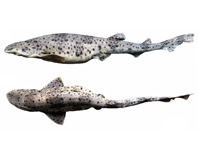Abstract
Gymnotus refugio, new species, is described from coastal rivers of Rio Grande do Sul and Santa Catarina states, Brazil. It is diagnosed from most species of the Gymnotus pantherinus species-group by the coloration pattern, further differing from G. pantherinus and G. capitimaculatus on the basis of morphometric and meristic characters. The new species represents the most meridional record of the G. pantherinus species-group.
References
Albert, J.S. (2001) Species diversity and phylogenetic systematics of American knifefishes (Gymnotiformes, Teleostei). Miscellaneous Publications Museum Zoology, University of Michigan, 190, 1–127.
Albert, J.S. & Crampton, W.G.R. (2001) Five new species of Gymnotus (Gymnotiformes, Teleostei) from an Upper Amazonian floodplain, with descriptions of electric organ discharges and ecology. Ichthyological Exploration Freshwaters, 12, 241–266.
Albert, J.S. & Miller, R.R. (1995) Gymnotus maculosus: a new species of electric fish from Middle America (Teleostei: Gymnotoidei), with a key to the species of Gymnotus. Proceedings Biological Society Washington, 108, 662–678.
Albert, J.S. & Crampton, W.G.R. (2003) Seven new species of the Neotropical electric fish Gymnotus (Teleostei, Gymnotiformes) with a redescription of G. carapo (Linnaeus). Zootaxa, 287, 1–54.
Albert, J.S., Crampton, W.G.R., Thorsen, D.H. & Lovejoy, N.R. (2005) Phylogenetic systematics and historical biogeography of the Neotropical electric fish Gymnotus (Teleostei: Gymnotidae). Systematics and Biodiversity, 2 (4), 375–417.
http://dx.doi.org/10.1017/S1477200004001574Campos-da-Paz, R. (1997) Sistemática e taxonomia dos peixes elétricos das bacias dos rios Paraguai, Paraná e São Francisco, com notas sobre espécies presentes em rios costeiros do leste do Brasil (Teleostei: Ostariophysi: Gymnotiformes). Unpublished Ph. D. Thesis, Universidade de São Paulo, São Paulo, 314 pp.
Corrêa, F., Oliveira, E.F., Tuchtenhagen, T., Pouey, J. & Piedras, S. (2015) Ichthyofauna of the hydrographic basin of the Chasqueiro Stream (Mirim Lagoon system, southern Brazil): generating subsidies for conservation and management. Biota Neotropica, 15 (4), e0006.
http://dx.doi.org/10.1590/1676-0611-bn-2015-0006Crampton, W.G.R. & Albert, J.S. (2003) Redescription of Gymnotus coropinae (Gymnotiformes, Gymnotidae) an often misidentified species of Neotropical electric fish, with notes on natural history and electric signals. Zootaxa, 348, 1–20.
Crampton, W.G.R. & Albert, J.S. (2004) Redescription of Gymnotus coatesi (Gymnotiformes: Gymnotidae), a rare species of electric fish from the lowland Amazon Basin, with descriptions of osteology, electric signals and ecology. Copeia, 2004, 525–533.
http://dx.doi.org/10.1643/CI-03-246R1Decreto Estadual (2014) Decreto No 51.797, de 9 setembro de 2014. Lista de Espécies da Fauna Ameaçada de Extinção no Rio Grande do Sul. Diário Oficial do Estado, 22 pp. Available from: http://www.al.rs.gov.br/filerepository/repLegis/arquivos/DEC%2051.797.pdf (accessed 16 December 2015)
Eschmeyer, W.N & Fong, J.D. (2015) Species of Fishes by family/subfamily. Electronic Database. http://researcharchive.calacademy.org/research/Ichthyology/catalog/fishcatmain.asp (accessed 9 October 2015)
Fernandes, F.M.C., Albert, J.S., Daniel-Silva, M.D.Z., Lopes, C.E., Crampton, W.G.R. & Almeida-Toledo, L.F. (2005) A new Gymnotus (Teleostei: Gymnotiformes: Gymnotidae) from the Pantanal Matogrossense of Brazil and adjacent drainages: continued documentation of a cryptic fauna. Zootaxa, 933, 1–14.
Hoedeman, J.J. (1962) Notes on the ichthyology of Surinam and other Guianas. 11. New gymnotiform fishes from Surinam and French Guiana, with additional records and a key to the groups and species from Guiana. Bulletin Aquatic Biology Amsterdam, 3, 97–107.
Giora, J., Malabarba, L.R. & Crampton, W.G.R. (2008) Brachyhypopomus draco, a new sexually dimorphic species of Neotropical electric fish from southern South America (Gymnotiformes: Hypopomidae). Neotropical Ichthyology, 6 (2), 159–168.
http://dx.doi.org/10.1590/S1679-62252008000200002LaMonte, F.R. (1935) Two new species of Gymnotus. American Museum Novitates, 781, 1–3.
Mago-Leccia, F. (1994) Electric Fishes of the Continental Waters of America. Biblioteca de la Academia de Ciencias Fisicas, Matematicas, y Naturales, Caracas, 206 pp.
Malabarba, L.R., Neto, P.C., Bertaco, V.A., Carvalho, T.P., Santos, J.F. & Artioli, L.G.S. (2013) Guia de identificação dos peixes da bacia do rio Tramandaí. Via Sapiens, Porto Alegre, 140pp.
Maxime, E.L., Lima, F.C.T. & Albert, J.S. (2011) A New Species of Gymnotus (Gymnotiformes: Gymnotidae) from Rio Tiquié in Northern Brazil. Copeia, 2011 (1), 77–81.
http://dx.doi.org/10.1643/CI-10-009Rangel-Pereira, F. de S. (2014) Gymnotus capitimaculatus, a new species of electric fish from rio Jucuruçu basin, northeastern Brazil (Ostariophysi: Gymnotiformes: Gymnotidae). Vertebrate Zoology, 64 (2), 169–175.
Taylor, W.R. & Van Dyke, G.C. (1985) Revised procedures for staining and clearing small fishes and other vertebrates for bone and cartilage study. Cybium, 9 (2), 107–119.
Steindachner, F. (1908) Über eine während der brasilianischen Expedition entdeckte Brachyplatystoma-Art aus dem Rio Parnahyba und über eine dicht gefleckte und gestrichelte Varietät von Giton fasciatus aus den Gewässern von Santos (Staat Sao Paulo). Anzeiger der Akademie der Wissenschaften in Wien, 45 (9), 126–130.

